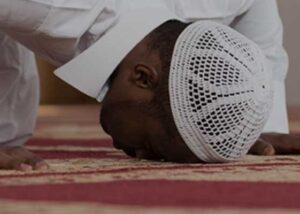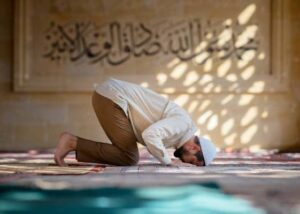Quran
Hadith
Islamic Text
The Isha start time in the Hanafi Madhab is differed over. We have two sound opinions in the Madhab. One considers Isha to start at the disappearance of the red twilight and the other opinion requires the disappearance of the white twilight. Both opinions are valid and one is permitted to follow either.
وَصَلَّى الْمَغْرِبَ حِينَ غَابَتِ الشَّمْسُ، وَصَلَّى الْعِشَاءَ حِينَ غَابَ الشَّفَقُ، وَصَلَّى الْفَجْرَ حِينَ طَلَعَ الْفَجْرُ
He (peace be upon him) prayed Maghrib when the sun set. Then he prayed Isha when the twilight disappeared, and prayed Fajr at daybreak. (Ahmad 11249, Sahih Lighayrihi).
The Mubarak Hadith above does not specify red or white twilight disappearing for the beginning of Isha. Therefore, the Sahabah and scholars who came after them differed regarding this issue.
(وَ)
وَقْتُ (الْمَغْرِبِ مِنْهُ إلَى) غُرُوبِ (الشَّفَقِ وَهُوَ الْحُمْرَةُ) عِنْدَهُمَا، وَبِهِ قَالَتْ الثَّلَاثَةُ وَإِلَيْهِ رَجَعَ الْإِمَامُ كَمَا فِي شُرُوحِ الْمَجْمَعِ وَغَيْرِهَا، فَكَانَ هُوَ الْمَذْهَبَ. (الدر المختار شرح تنوير الأبصار وجامع البحار)
Maghrib time is from it (sunset) until the disappearance of the twilight, which refers to the red twilight, according to the Saahibayn. The other three Imams went with it too. Imam (Abu Hanifah) returned to this opinion (too), as has been narrated in the commentaries of al-Majma and other (works). Therefore, it is the position of the Madhab. (Imam al-Haskafi, Durr al-Mukhtaar).
As seen in the Nass above many Hanafi Imams went with the opinion that Isha starts at the disappearance of the red twilight, and they considered it to be the position of the Madhab. They even believed that Imam Abu Hanifah ended up on this opinion, although they acknowledge he used to hold the opinion of white twilight.
In his Haashiyah upon Durr al-Mukhtar, Imam Ibn Abideen disputes much of this. However he certainly recognises that the disappearance of the red twilight is the opinion of the Saahibayn and is a credible opinion in the Madhab. It is not a weak opinion.
(قَوْلُهُ: وإلَيْهِ رَجَعَ الْإِمَامُ)
أَيْ إلَى قَوْلِهِمَا الَّذِي هُوَ رِوَايَةٌ عَنْهُ أَيْضًا، وَصَرَّحَ فِي الْمَجْمَعِ بِأَنَّ عَلَيْهَا الْفَتْوَى، وَرَدَّهُ الْمُحَقِّقُ فِي الْفَتْحِ بِأَنَّهُ لَا يُسَاعِدُهُ رِوَايَةٌ وَلَا دِرَايَةٌ إلَخْ. وَقَالَ تِلْمِيذُهُ الْعَلَّامَةُ قَاسِمٌ فِي تَصْحِيحِ الْقُدُورِيِّ: إنَّ رُجُوعَهُ لَمْ يَثْبُتْ، لِمَا نَقَلَهُ الْكَافَّةُ مِنْ لَدُنْ الْأَئِمَّةِ الثَّلَاثَةِ إلَى الْيَوْمِ مِنْ حِكَايَةِ الْقَوْلَيْنِ، وَدَعْوَى عَمَلِ عَامَّةِ الصَّحَابَةِ بِخِلَافِهِ خِلَافُ الْمَنْقُولِ. (رد المحتار على الدر المختار)
His saying: And to it the Imam returned. Meaning to their (the Sahibayn’s) opinion. Which is a narration from him (Imam Abu Hanifah) too. In al-Majma’ he was explicit regarding the fact that the Fatwa is upon it (red twilight). However, the Mohaqiq (Imam Ibn Humaam) refuted him, saying this is not supported by narration or comprehension.
His student Allamah Qasim said in Tasheeh al-Qudoori: His (Imam Abi Hanifah) switching (to the position of the Saahibayn) is not established. Due to what has been narrated by an abundance of scholars from the time of the three Imams to our time, that there are two opinions (regarding Isha). Also, the claim that most Sahabah acted against it (white twilight) contradicts the narrations. (Radd al-Muhtaar, Imam Ibn Abideen).
The Nass above makes it clear that there is a difference of opinion regarding Isha start time in the Hanafi Madhab. It also speaks about the fact that this is an issue Sahabah differed over.
قَالَ فِي الِاخْتِيَارِ: الشَّفَقُ الْبَيَاضُ، وَهُوَ مَذْهَبُ الصِّدِّيقِ وَمُعَاذِ بْنِ جَبَلٍ وَعَائِشَةَ – رَضِيَ اللَّهُ عَنْهُمْ -. قُلْت: وَرَوَاهُ عَبْدُ الرَّزَّاقِ عَنْ أَبِي هُرَيْرَةَ وَعَنْ عُمَرَ بْنِ عَبْدِ الْعَزِيزِ، وَلَمْ يَرْوِ الْبَيْهَقِيُّ الشَّفَقَ الْأَحْمَرَ إلَّا عَنْ ابْنِ عُمَرَ، وَتَمَامُهُ فِيهِ. وَإِذَا تَعَارَضَتْ الْأَخْبَارُ وَالْآثَارُ فَلَا يَخْرُجُ وَقْتُ الْمَغْرِبِ بِالشَّكِّ كَمَا فِي الْهِدَايَةِ وَغَيْرِهَا. (رد المحتار على الدر المختار)
He said in al-Ikhtiyaar: The white twilight is the opinion of al-Siddique, Mu’adh bin Jabal and (Sayidah) Ayeshah (May Allah Most High be pleased with them all). I (Ibn Abideen) say, and (Imam) Abd al-Razzaq narrated it (white twilight) from Abu Hurairah (May Allah Most High be pleased with him) and Umar bin Abd al-Aziz. (Imam) al-Bayhaqi did not narrate the red twilight from anyone except Ibn Umar (May Allah Most High be pleased with him), the rest of the discussion is found in it. When the narrations and reports differ, then Maghrib time does not exit in a situation of doubt, as has been mentioned in al-Hidaayah and other works. (Radd al-Muhtaar, Imam Ibn Abideen).
It is important to recognise that many of the differences found within the Madhaahib of Ahl al-Sunnah are traced back to the Sahabah. Some ignorant people spread the falsehood that the Madhaahib (Schools of Fiqh) have caused division in the Ummah. They do not realise that they are in fact attacking the Sahabah when they say such things. As they were the first generation to differ over aspects of the Deen. However, they respected such differences. This is something that those who oppose Madhaahib must learn from.
قَالَ الْعَلَّامَةُ قَاسِمٌ: فَثَبَتَ أَنَّ قَوْلَ الْإِمَامِ هُوَ الْأَصَحُّ، وَمَشَى عَلَيْهِ فِي الْبَحْرِ مُؤَيِّدًا لَهُ بِمَا قَدَّمْنَاهُ عَنْهُ، مِنْ أَنَّهُ لَا يُعْدَلُ عَنْ قَوْلِ الْإِمَامِ إلَّا لِضَرُورَةٍ مِنْ ضَعْفِ دَلِيلٍ أَوْ تَعَامُلٍ بِخِلَافِهِ كَالْمُزَارَعَةِ، لَكِنَّ تَعَامُلَ النَّاسِ الْيَوْمَ فِي عَامَّةِ الْبِلَادِ عَلَى قَوْلِهِمَا، وَقَدْ أَيَّدَهُ فِي النَّهْرِ تَبَعًا لِلنُّقَايَةِ وَالْوِقَايَةِ وَالدُّرَرِ وَالْإِصْلَاحِ وَدُرَرِ الْبِحَارِ وَالْإِمْدَادِ وَالْمَوَاهِبِ وَشَرْحِهِ الْبُرْهَانَ وَغَيْرِهِمْ مُصَرِّحِينَ بِأَنَّ عَلَيْهِ الْفَتْوَى. وَفِي السِّرَاجِ: قَوْلُهُمَا أَوْسَعُ وَقَوْلُهُ أَحْوَطُ، وَاَللَّهُ أَعْلَمُ. (رد المحتار على الدر المختار)
Allamah Qasim said : Therefore it is established that the opinion of the Imam is the strongest. He (Imam Ibn Nujaym) went with it in al-Bahr, supporting it by saying that it is not acceptable to turn away from the Imam’s opinion except if there is a necessity like, weakness of evidence, or contradicting established practice like Mudhara’ah. However the established practice of the people in most places is upon their (the Saahibayn’s) opinion, he supported it in al-Nahr following al-Nuqayah, al-Wiqayah, al-Islaah, Durar al-Bihaar, al-Imdaad, al-Mawahib, its commentary al-Burhaan and other works that explicitly mentioned that the Fatwa is upon it. In al-Siraaj he said their opinion is more facilitating and his is more cautious. And Allah (Most High) knows best. (Radd al-Muhtaar, Imam Ibn Abideen).
In the Nass above Imam Ibn Abideen makes it clear that both opinions have been validated and are strong. Therefore, a person who follows the Hanafi Madhab can follow either of these opinions. In the late spring and early summer months, Isha is very late, so it would be best for Masaajid to establish the Isha Jama’ah (congregational prayer) at the disappearance of the red twilight.
Although I have quoted from more advanced works of the Hanafi Madhab, a person does not have to study such works to be well aware of this Ikhtilaaf (difference) between the Imam and his students. Rather it is established in beginners works of the Hanafi Madhab (Mutoon).
And Allah Most High Knows Best.
– Answered by Shaykh Noorud-deen Rashid (09.06.2022)
See also:
Why are Ramadan timetables differing on the start of Fajr?
See also video:






